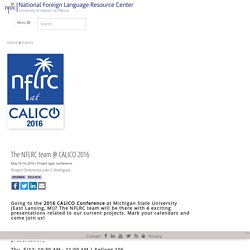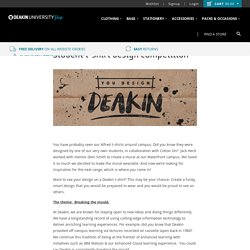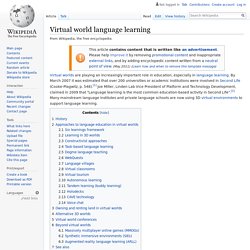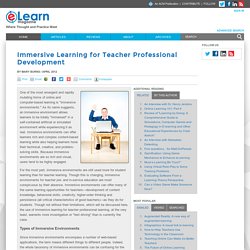

Fabricante de la Tira Cómica. NFLRC. Going to the 2016 CALICO Conference at Michigan State University (East Lansing, MI)?

The NFLRC team will be there with 4 exciting presentations related to our current projects. TECH INNOVATION Simulation Vignette 1. Standards Of Best Practice: Simulation. Complete%202013%20Standards. Student t-shirt design competition - Deakin University shop. You have probably seen our Alfred t-shirts around campus.

Did you know they were designed by one of our very own students, in collaboration with Cotton On? Jack Herd worked with mentor Glen Smith to create a mural at our Waterfront campus. We loved it so much we decided to make the mural wearable. And now we’re looking for inspiration for the next range, which is where you come in! Want to see your design on a Deakin t-shirt? The theme: Breaking the mould. At Deakin, we are known for staying open to new ideas and doing things differently. Your ‘breaking the mould' design can be as abstract or as literal as you like! Send your design in before July 27th for your chance to win a $2,000 VISA® prepaid card and for your design to be featured in the Deakin Merchandise shop.
A selection panel will decide on the top 6 designs, students will then get a chance to vote for their favourite entry. How to enter Step 1: Download the design template here and read the terms and conditions. Simulated assessment. A key part of the learning experience is the sharing of new information - some would say that an even more important step is that the learner uses, adapts, critiques or applies the information in a situation that closely resembles the intended context.

For example, pharmacy students often learn information about drugs and their interactions. Better learning occurs when they practice applying that knowledge in a pharmacy, or in a simulated pharmacy. Assessment, in its broadest meaning, is the opportunity to apply information for practice (this informs the learner if they have mastered the new information, and is often referred to as formative assessment), or for a record of achievement (such as marks - this is often referred to as summative assessment). Games use this technique: the player is immersed in a context, has tasks and quests, and learns through trial and error to advance to more challenging tasks and levels. Examples of simulations are available below. Example 10: Simple games. Virtual world language learning. Virtual worlds are playing an increasingly important role in education, especially in language learning.

By March 2007 it was estimated that over 200 universities or academic institutions were involved in Second Life (Cooke-Plagwitz, p. 548).[1] Joe Miller, Linden Lab Vice President of Platform and Technology Development, claimed in 2009 that "Language learning is the most common education-based activity in Second Life".[2] Many mainstream language institutes and private language schools are now using 3D virtual environments to support language learning.
History[edit] Virtual worlds date back to the adventure games and simulations of the 1970s, for example Colossal Cave Adventure, a text-only simulation in which the user communicated with the computer by typing commands at the keyboard. Three-dimensional virtual worlds such as Traveler and Active Worlds, both of which appeared in the 1990s, were the next important development. The 3D world of Second Life was launched in 2003. World Language Learning Pedagogical Approach. Middlebury Interactive’s proven world language learning curriculum—adapted for the digital age—uses authentic materials and task-based activities to immerse students in language and culture.

Middlebury Interactive Languages was founded on the principle that proven language immersion curriculum could be applied to digital and blended learning environments as an effective way to teach a new language. In fact, the success of our digital programs has shown that students thrive when they are challenged with rigorous curriculum, engaging learning tools and well-supported and trained teachers. This approach has been followed in the design and implementation of all the offerings (from fully online to blended solutions), for all grade levels (from elementary through Advanced Placement), and all languages (Chinese, French, German, Spanish and English for non-native speakers). Curriculum for all of our courses was developed exclusively for K-12 learners by Ph.D. 1. 2. Immersive Learning for Teacher Professional Development. One of the most emergent and rapidly mutating forms of online and computer-based learning is "immersive environments.

" As its name suggests, an immersive environment allows learners to be totally "immersed" in a self-contained artificial or simulated environment while experiencing it as real. Immersive environments can offer learners rich and complex content-based learning while also helping learners hone their technical, creative, and problem-solving skills. Because immersive environments are so rich and visual, users tend to be highly engaged. A Review of the Current Research on Vocabulary Instruction. Modeling & Simulation 101. What is Simulation? Engaging Students with Language Simulation: Interview with Dr. Jodi Tommerdahl. LLT Vol7Num1: DESIGNING TASK-BASED CALL TO PROMOTE INTERACTION: EN BUSCA DE ESMERALDA. DESIGNING TASK-BASED CALL TO PROMOTE INTERACTION: EN BUSCA DE ESMERALDAS Paginated PDF version Marta González-Lloret University of Hawai'i ABSTRACT Developing effective language teaching materials based on second language acquisition principles is a priority which needs to be addressed in all language teaching areas.

The field of computer-assisted language learning (CALL) is no exception. "En Busca de Esmeraldas" is a CALL activity delivered via the Internet and based on principles of language teaching (Doughty & Long, 2002; Long, in press) and on Chapelle's (1998) proposals for developing multimedia, grounded in SLA research. The first part of this article presents the steps necessary for designing an effective language learning tool to foster communication and negotiation, taking into consideration the importance of supporting integral education, using tasks, providing elaborated input and feedback, and promoting collaborative learning. 1. 1.
*S7 = student 7 Table 4. Table 5.